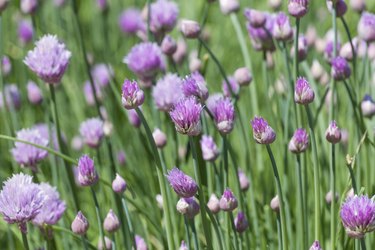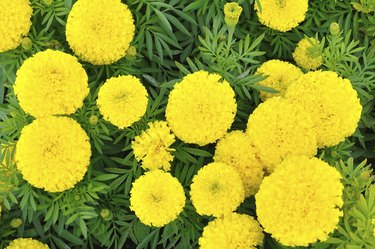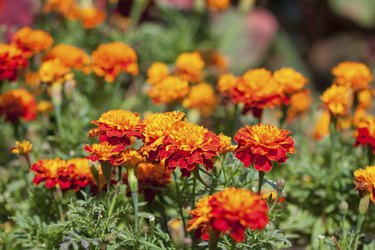
With all the garden pests that chomp on leaves, stems and roots, it's nice that some plants fight back. They produce essential oils that make their parts offensive to insect predators. For example, you might want to plant a patch of catnip (Nepeta cataria) even if you haven't got a cat or herbs when you're not planning to use them in the kitchen. Some plants even protect other plants. With all plants, crush or brush against foliage for best effects.
Herbal Helpers
Video of the Day

The group known as herbs might have insignificant flowers, but they share a remarkable ability to produce essential oils that bugs hate. Their mounds of blue or white flowers make lovely fillers in containers as well as beds and borders. Catnip, which grows in U.S. Department of Agriculture plant hardiness zones 3 through 7, might attract cats, but its pungent minty odor mightily offends and repels the bug world from ants and aphids to mosquitoes and weevils. Chives (Allium schoenoprasum), which grow in USDA zones 4 through 8, offend Japanese beetles and carrot rust flies. Basil (Ocimum basilicum), an annual herb, deters flies and mosquitoes.
Video of the Day
Flower Power

Plant bedding flowers that bugs hate throughout beds and borders to encourage them to move along to the next garden. Wormwood (Artemesia "Powis Castle"), hardy in USDA zones 6 through 9, repels a variety of bugs in the flower garden. Lavender (Lavendula angustifolia), which grows in USDA zones 5 through 8, repels fleas and moths. Petunias (Petunia grandiflora), which grow in USDA zones 9 through 11, discourage leafhoppers, aphids and mosquitoes. Annual French marigolds (Tagetes patula) repel whitefies and nematodes. Use inexpensive bedding plants to protect more expensive perennials.
Vegetable Garden Warriors

Annual herbs and flowers excel in vegetable garden protection. French or African marigolds (Tagetes patula) are favorite border guardians in many vegetable gardens. Nasturtiums (Tropaeolum spp.) offend wooly aphids, whiteflies, squash bugs and cucumber beetles. Don't forget to tuck chives and some garlic (Allium sativum), hardy in USDA zones 4 through 9, in for their repellant as well as savory qualities. Rotate plant families to avoid establishing insect colonies that overwinter from year to year.
Companion Guardians

Despite repeated fruitless efforts to establish a scientific basis for the theory of companion plantings, folklore persists that some plants make good neighbors. Some express their neighborliness by repelling insects. Garlic repels aphids when planted near roses (Rosa spp.), which grow in USDA zones 2 through 10. Basil improves the taste of tomatoes (Lycopersicon esculentum) and may also repel tomato hornworms. Tansy (Tanacetum haradjanii), hardy in USDA zones 8 through 10 and pennyroyal (Mentha puleguim) may deter ants. Other mints (Mentha spp.), which grow in USDA zones 4 through 10, depending on species, may repel cabbage moths when paired with broccoli (Brassica oleracea) and other plants in the cabbage family. Alternately, use "trap" plants that draw bugs from other plants. For example, annual squashes (Curcubita spp.) protect cucumbers (Cucumis sativus) against pickleworms.
- University of Illinois Extension: Use Plants for Pest Control
- University of Nebraska-Lincoln Nebraska Extension in Lancaster County: Catnip Attracts Cats and Repels Pests
- North Carolina State University Cooperative Extension: Plants That Naturally Reduce Mosquitoes
- Mother Nature Network: 12 Plants That Repel Unwanted Insects
- Alabama A&M and Auburn Universities Cooperative Extension: Insect Pest Management in the Home Vegetable Garden
- Missouri Botanical Garden: Pest-Repelling Plants
- Cornell University Cooperative Extension: Companion Planting